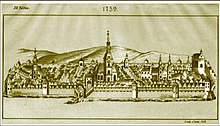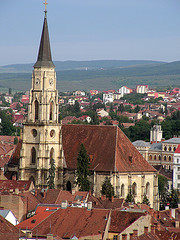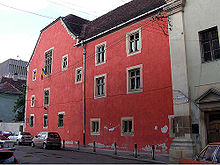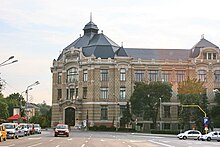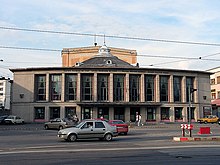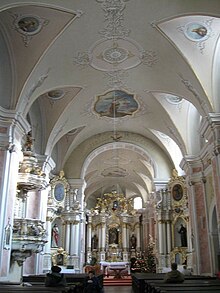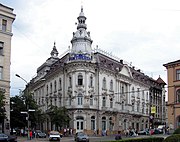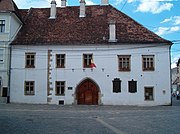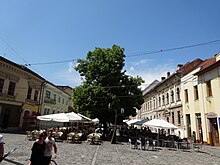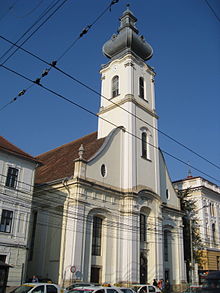Cluj-Napoca
|
Cluj-Napoca Cluj Kolozsvár |
||||
|
||||
| Basic data | ||||
|---|---|---|---|---|
| State : |
|
|||
| Historical region : | Transylvania | |||
| Circle : | Cluj | |||
| Coordinates : | 46 ° 47 ' N , 23 ° 36' E | |||
| Time zone : | EET ( UTC +2) | |||
| Height : | 340 m | |||
| Area : | 179.5 km² | |||
| Residents : | 324,576 (October 20, 2011) | |||
| Population density : | 1,808 inhabitants per km² | |||
| Postal code : | 400001-400930 | |||
| Telephone code : | (+40) 02 64 | |||
| License plate : | CJ | |||
| Structure and administration (as of 2016) | ||||
| Community type : | Municipality | |||
| Mayor : | Emil Boc ( PNL ) | |||
| Postal address : | St. Moților, no. 1-3 loc. Cluj-Napoca, jud. Cluj, RO-400001 |
|||
| Website : | ||||

Cluj-Napoca , German Klausenburg ([ ˈkluːʒ naˈpɔka ]; ; until 1974 Cluj , Hungarian Kolozsvár , Latin Claudiopolis / Claudianopolis ), is the second largest city in Romania . It is the capital of the Cluj County in Transylvania and the seat of the Northwest Planning Region . The city has 324,576 inhabitants (as of October 2011).
geography

Cluj-Napoca is located in western Transylvania on the Someșul Mic (Little Somesch) river . The area is characterized by mountains and forests. In addition to some lakes, streams and rivers such as Someșul Mic, there are also underground waters.
The continental temperate climate creates large seasonal temperature fluctuations with hot, dry summers and cold winters.
From the hills to the south near Feleacu you have a beautiful panoramic view of the city.
City structure
The city center with its historical buildings is mainly surrounded by large prefabricated housing estates from the communist era: Mănăştur (German, formerly Abtsdorf ) and Grigorescu in the west, Mărăşti and Gheorgheni in the east and Zorilor south of the center .
The districts of Iris , Bulgaria and Dâmbul Rotund are mainly industrial. Gruia , Someșeni (independent suburb until 1960) and Andrei Mureșanu are among the older single-family housing estates, there are also other, sometimes very young, residential areas and residential parks.
Neighboring communities
The following communities border the city: to the north of Chinteni , to the east of Apahida , to the south of Feleacu (Fleck) , to the west of Floreşti (Saxon Fenesch) and to the north-west of Baciu . Especially since the beginning of the 21st century, many people from Cluj have moved from the city to newly built residential complexes in the surrounding area.
Climate table
| Cluj-Napoca | ||||||||||||||||||||||||||||||||||||||||||||||||
|---|---|---|---|---|---|---|---|---|---|---|---|---|---|---|---|---|---|---|---|---|---|---|---|---|---|---|---|---|---|---|---|---|---|---|---|---|---|---|---|---|---|---|---|---|---|---|---|---|
| Climate diagram | ||||||||||||||||||||||||||||||||||||||||||||||||
| ||||||||||||||||||||||||||||||||||||||||||||||||
|
Average monthly temperatures and rainfall for Cluj-Napoca
Source: wetterkontor.de
|
|||||||||||||||||||||||||||||||||||||||||||||||||||||||||||||||||||||||||||||||||||||||||||||||||||||||||||||||||||||||||||||||||||||||||||||||||||||||||||||||||||||
history
Early history
In prehistoric times, there was temporarily a settlement on the site of today's city. After the Roman conquest of Dacia under Emperor Trajan , this Dacian settlement Napoca was expanded into a legionary camp , but the civil settlement as a traffic junction quickly developed into a locally important small urban center. Already under Emperor Hadrian (117-138) Napoca received the rights of a municipality and was now called Municipium Aelium Hadrianum Napoca . A Roman colony was probably founded under Emperor Marcus Aurelius . In the 3rd century Napoca outstripped the provincial capital Porolissum for a few years and became the seat of the procurator . Around 250 the settlement went under in the course of devastating raids by Teutons and Carps and the withdrawal of the small Romanized population.
middle Ages
The city was built in the 13th century by German settlers on the banks of the Someșul Mic river ( Little Samosh ). Cluj-Napoca, the second largest city in the Kingdom of Hungary , has been the seat of Cluj County since then .
The Hungarian King Matthias Corvinus was born here in 1443.
From 1523 Protestant writings by Martin Luther and Philipp Melanchthon came to the city. The Reformation of the Helvetic Confession was introduced around 1550 because the estates had given each other the freedom to choose their faith.
18th and 19th centuries
From 1790 to 1848 and from 1861 to 1867, Cluj was the capital of the Grand Duchy of Transylvania within the Habsburg Monarchy. After the Austro-Hungarian Compromise of 1867, Transylvania became an integral part of Hungary. The Saxon part of the population acculturated to the Hungarian in the 17th and early 18th centuries. The reasons were the turn to Unitarianism during the Reformation, which the other Transylvanian Saxons did not implement, and the lack of a compact German-populated surrounding area. Rather, the area around Klausenburg was until the 17th and 18th centuries. Century predominantly inhabited by Romanians and Hungarians, with the exception of Saxon Fenesch . In 1872 the second university within historical Hungary was founded in Cluj, the Franz Josef University (today University of Szeged ).
20th century
After the First World War , on June 4, 1920, Transylvania was incorporated into Romania through the Trianon Peace Treaty . In 1940 Northern Transylvania and Cluj returned to Hungary through the Second Vienna Arbitration . With the German occupation of Hungary from 1944 to 1945, Klausenburg came under German administration. The history of Cluj-Napoca is closely intertwined with the history of the Holocaust . With the Hungarian annexation in 1940, economic restrictions and forced labor were imposed on the Jewish inhabitants, who in 1920 accounted for 14,000 people, 13.4% of the urban population. In 1941 several hundred Jews were deported and murdered in Kamianets-Podilskyi . After the German invasion, around 18,000 Jews from Cluj-Napoca, Gherla and the surrounding area were crammed into the city's brickworks and sent from there to the extermination camps . 388 Cluj-Napoca Jews were spared and saved from this deportation thanks to a controversial agreement between the Jewish journalist and lawyer Rudolf Kasztner and the SS. After the Paris Peace Conference in 1946 , Cluj reverted to Romania in 1947.
In 1974 Nicolae Ceaușescu added the ancient Roman name “Napoca” to the Romanian place name Cluj in order to enforce the official theory of the ancestry of Romanians from Dacians and Romans (see Dako-Roman continuity theory ). In everyday life, however, this name change was only moderately successful; the name “Cluj” is still used.
present
Today it is one of the most important cultural, economic and scientific centers in Romania. With over ten practiced religions, Cluj-Napoca has a great religious diversity, with the majority of the residents belonging to the Orthodox faith since the 1970s.
Cluj is still the cultural center of the Hungarian minority in Romania today. Until about 1974 the Hungarians made up the relative majority of the population in the city.
population


According to the 2002 census, 79.4% of the population of Cluj are Romanians , 19% Hungarians and Szeklers , 1% Roma and 0.23% Romanian Germans (mostly Transylvanian Saxons ). The city has not lost its multi-ethnic character, which has shaped the city since the Middle Ages, even if there was a shift in the proportion of the population, especially in the course of the 20th century. In 1910, of the almost 61,000 inhabitants at that time, 83.4% were Hungarians, 12.4% Romanians and 2.8% German.
The majority of the city's population belongs to the Romanian Orthodox Church (69.2%). In addition, 12.2% are Reformed , 5.8% Greek Catholic , 5.5% Roman Catholic , 1.2% Baptist , 1% Unitarian and 0.07% Jewish . The Jewish community has around 500 members, in the interwar period their share in the total population of Cluj was still 13%.
In August 2009, 4,777 were registered as unemployed.
Of the 324,576 people registered in the 2011 census, 245,737 were Romanians, followed by 49,565 Magyars, 3,273 Roma, 544 Romanian Germans, 155 Jews , 127 Ukrainians , 88 Italians , 71 Greeks , 64 Turks , etc. a. Ethnic groups in smaller numbers.
German
Several hundred Transylvanian Saxons and members of other German-speaking ethnic groups still live in Cluj-Napoca. Cluj-Napoca has traditionally been one of the centers of Transylvanian-Saxon culture for centuries. In the inter-war period, 2,000 to 3,000 German speakers per year studied at the city's university. The city continues to play an important role in education thanks to the educational institution known today as Babeș-Bolyai University , which has also been offering German-language courses since 1995. There are also German kindergarten groups and school lessons, libraries with German-language literature and the German Cultural Center in Cluj-Napoca . The Democratic Forum of Germans in Romania (DFDR) has had a branch in the city center since 1990. In 1996 the German Youth Forum was founded in Cluj-Napoca.
Magyars
With around 60,000 Hungarians and Szeklers, Cluj is the second largest Magyar minority in Romania after Târgu Mureș (Neumarkt am Mieresch) . There is an intact 'Hungarian infrastructure' in the form of schools or school classes and universities with Hungarian as the language of instruction, clubs, pubs, parishes, theaters, an opera, etc. Since, according to official Romanian information, Magyars make up just under twenty percent of the total city population, Hungarian is no official language of the local administration.
Roma
As in many other places in Romania, there is a Roma settlement on the outskirts of the city , with almost 2,000 inhabitants living in poor conditions. It is located next to a garbage dump in the eastern part of Someșeni . However, not all Roma in the city live here.
A non-governmental information center for Roma (Centrul de Resurse pentru Comunitățile de Romi) has existed in Cluj since 2000 , with the aim of improving the living conditions in which Roma live.
Politics and administration

The city council (also local council, Romanian consiliul local ), whose composition is elected every four years, consists of 27 members. After the election on June 24, 2012, the council was composed as follows:
- Uniunea Social Liberală ( USL, Social Liberal Union ) - 12 seats
- Partidul Democrat Liberal ( PD-L, Democratic Liberal Party ) - 10
- Democratic Union of Hungarians in Romania ( UDMR, Union of Hungarians in Romania ) - 4
- Partidul Poporului - Dan Diaconescu ( PP-DD, People's Party Dan Diaconescu ) - 1
There are six district halls, but they have no function as the seat of parliament, administration or a district mayor of the respective district. They were introduced by Emil Boc so that citizens can deal with part of their administrative affairs as close as possible to their homes.
Metropolitan area
Cluj-Napoca is the center of the metropolitan region of the same name ( Zona metropolitană Cluj-Napoca ) , along with seventeen other municipalities in the area. The total population of the metropolitan area is approx. 380,000 inhabitants. The aim is to jointly develop the infrastructure.
Town twinning
Cluj-Napoca has partnerships with 20 cities / municipalities worldwide:
|
|
education
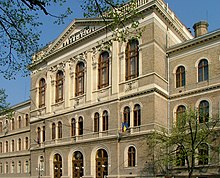
The character of Cluj as a university city is unmistakable through its students, especially during the lecture periods. The Babes-Bolyai University , with over 45,000 students, the largest state among the six colleges of the city, in the region of Eastern and Central Europe is important. As a trilingual university - Romanian, Hungarian and German - it is a rarity in Europe. The university was founded in 1872 and its history dates back to the 16th century. This is how you name today's seal 1581 as the year of origin of the Jesuit College, which was founded on the initiative of Stephan Báthory .
The University of Agricultural Sciences and Veterinary Medicine (USAMV) has existed since 1869. The other state universities or their respective predecessors are foundations from the interwar period: Technical University of Cluj-Napoca , Medical and Pharmaceutical University Iuliu Hațieganu , University of Art and Design , Gheorghe Dima Music Academy . Private universities have sprung up since the 1990s. This includes the Hungarian-speaking Sapientia University of Transylvania, founded in 2001 .
In the city center there is a branch of the Romanian Academy with headquarters in Bucharest. The academy runs a total of eleven facilities in Cluj. These include the Center for Transylvanian Studies, the Folklore Archive with collections of Romanian, Hungarian and Transylvanian-Saxon folk art, the Astronomical Institute with an observatory and the Tiberiu Popoviciu Institute for Numerics.
State universities
- Babes Bolyai University
- Technical University
- Agricultural and Veterinary University
- Iuliu Hațieganu Medical and Pharmaceutical University
- University of Art and Design
- Gheorghe Dima Music Academy
Private universities
Some private or church universities:
- Christian University of Dimitrie Cantemir
- Protestant Theological Institute
- Sapientia University (largest Hungarian-speaking private university in Romania)
schools
There are around thirty lyceums (grammar schools) in Cluj, including various ecclesiastical ones , the Sigismund Toduță Music Lyceum , the Romulus Ladea Art Lyceum , the Octavian Stroia Lyceum for Dance and Drama, a Waldorf Lyceum and a Blind Lyceum, depending on the religious diversity of the city . In addition, there are kindergartens, primary schools, special 'vocational schools', e.g. B. the railway, and the George Coşbuc National College, in which all twelve grades are taught.
Several schools and kindergartens are Hungarian or have Hungarian sections. In addition to the Romanian section, the Nationalkolleg has a German-speaking section with two to three German classes per level. It is a partner school of the Federal Republic of Germany .
Libraries
- Octavian Goga District Library
- University library "Lucian Blaga" with the central library, branches and special facilities (American, British, German and Austrian library as well as library for Jewish studies)
- Library of the Romanian Academy
- Libraries of the cultural institutes
Arts and Culture
Cluj is one of the most important cultural centers in Transylvania and Romania. The historic buildings in the largely preserved old town bear witness to the city's cultural past.
The brothers Georg and Martin von Klausenburg , who were among the most important European sculptors of the 14th century , show that artistic craftsmanship was highly developed in medieval Cluj . The equestrian statue of St. George for the Prague Hradschin (1373) comes from them . At the time, there was no equivalent for the shape and technique of the statue, the copy of which is in downtown Cluj.
Theater and film
The first Hungarian-speaking theater group in Transylvania was founded here in 1792, followed by the construction of its own theater building in 1821. The National Theater was built between 1904 and 1906 according to the plans of the Viennese architects Fellner & Helmer . At the beginning of the 20th century, Klausenburg was a center for silent film productions. a. the director Michael Curtiz and Alexander Korda . The initiatives of Jenő Janovics , the city's theater director since 1902, who advocated the medium of film, were formative.
Today, two theaters - the Romanian National Theater (Teatrul Național Lucian Blaga) and the Hungarian State Theater (Teatrul Maghiar de Stat) - as well as the Transylvania International Film Festival (TIFF), which has been held annually since 2002, continue this tradition. There is also a puppet theater (Teatrul de Păpuși "Puck") .
Cluj has five cinemas, including the three 'classic' houses Florin Piersic (formerly Republica ), Arta and Victoria in the city center, which already existed in communist times and today show not only international films but also smaller film productions. Two multiplex cinemas opened in 2008 and 2009 respectively.
Opera and music
As in the theater sector, there is a separate opera house for the Hungarian minority (Opera Maghiară) next to the Romanian National Opera (Opera Națională Română) . Cluj saw the first opera performance in 1822. Especially under Janovics, opera experienced a modern development from around 1900. After the city was awarded to Romania after the First World War, the Romanian Opera was founded in 1919, the first Romanian-language performance took place the following year. The Hungarian opera was preserved as part of the Hungarian-language theater, but could only survive in the inter-war period with difficulty - still under Janovics' leadership. The Hungarian Opera in its current, independent form has existed since 1948.
The Transilvania State Philharmonic ( Filarmonica de Stat Transilvania ) was founded in 1955. In addition to the symphony orchestra, it includes a choir, a chamber orchestra, the Transilvan string quartet and a folklore group. The orchestras of the older theater and opera ensembles were the pioneers of the Philharmonie. For example, before the Second World War there was an Orchestra Operei Naționale din Cluj - an opera orchestra. The Goldmark Orchestra was actually independent in the 1930s, in which Jewish community members played together. In 1947, attempts were finally made to set up a new philharmonic orchestra. The Filarmonica Ardealul only lasted two seasons, but formed a foundation for the establishment of the State Philharmonic shortly afterwards.
The outstanding musical events of the year include the Mozart Festival for Classical Music and the Transylvania Jazz Festival .
There is an electronic music scene that is played in clubs. The Untold Festival of Electronic Dance Music has been taking place in Central Park every year since 2015 at the beginning of August. In the field of alternative rock music, KUMM is especially known beyond the city limits.
Museums
There are a number of museums in the city:
- Museum of Art ( Muzeul de Artă ) in the Bánffy Palace
- National Museum of the History of Transylvania (Muzeul Național de Istorie a Transilvaniei)
- Transylvanian Ethnographic Museum (Muzeul Etnografic al Transilvaniei)
- Romulus Vuia open-air museum (Parcul etnografic național Romulus Vuia)
- Pharmacy Museum (Muzeu de Farmacie)
- Museums of the Babes Bolyai University
- University Museum (Muzeul Universității)
- Mineralogy Museum (Muzeul de Mineralogie)
- Botanical Museum (Muzeul Botanic)
- Paleontological Museum (Muzeul de Paleontologie-Stratigraphie)
- Vivarium (Vivariu)
- Zoological Museum (Muzeul Zoologic)
Multicultural center
Due to its strong Magyar population, Cluj is one of the focal points of the Hungarian-Transylvanian culture. There are Hungarian publishers, bookshops and cultural institutions.
There is a Confucius Institute at Babes Bolyai University and an American Corner at Octavian Goga District Library . In addition to the German one, there is also a French, an Italian and a Japanese cultural center as well as a branch of the British Council .
Cultural festivals
- Comedy Cluj Film Festival
- Serile Filmului Gay Gay Film Festival
- Festival Temps d'images
- Puck puppet theater festival
- Experimental theater festival
- Toamna Muzicală Clujeană Classical Music Festival
- SoNoRo Chamber Music Festival
- Transeuropean Festival
- Transilvania International Film Festival
- Transilvania International Guitar Festival
- Transilvania Jazz Festival
- Szent István international folklore festival
gastronomy
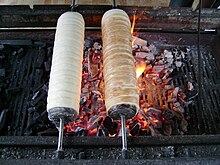
The traditional "Cluj-Napoca" cuisine, like all of Transylvania , is shaped by Hungarian, Romanian, Transylvanian-Saxon and Austrian influences. For example, there are also some Viennese-style coffee houses in the city . Dishes that bear the name of the city are the Klausenburger cabbage (Varză á la Cluj) and Klausenburger bacon .
The Ursus brewery has existed since 1878 .
Sports
The CFR Cluj is the currently most successful football club in the city. He plays in the highest Romanian league 1 and last won the championship title in 2011/2012. There are two major football stadiums in the city: the Dr. Constantin Rădulescu Stadium of CFR Cluj and the Stadionul Clujana of Universitatea Cluj . The new Ion Moina stadium of the Cluj-Napoca municipality opened in 2011. The no longer existing football club Victoria Cluj was temporarily successful .
There are also other successful teams in team sports in Cluj-Napoca. The Romanian basketball champion of the 2010/11 season is the team from Universitatea Cluj-Napoca , which has won this title several times before. The national champion of the 2018 season in cricket was the Cluj Cricket Club .
Other sports facilities in the city include:
- Olympic swimming pool
- Horea Demian sports arena
- Iuliu Hațieganu Sports Park
- Skateboard area in Caragiale Park
In 2017 the European Gymnastics Championships took place in Cluj-Napoca .
Attractions
The main attractions of Cluj-Napoca are to be found in the city center, whose historic buildings from the time before World War II have largely been preserved. Their different architectural styles shape the cityscape. From the earlier period of the history of Cluj-Napoca , the medieval Gothic , of which the most important and best-known example of the city is the Michael's Church , Renaissance buildings and the baroque aristocratic palaces from the early modern period are characteristic. In the 19th century and the beginning of the 20th century, numerous representative buildings in the classicist , eclectic and art nouveau styles were built .
Some larger buildings were built in the city center during the communist era , such as the Telephon Palace in brutalist style, the Hotel Belvedere , the library of the Romanian Academy and the Central department store (modern facade today).
Streets and squares
Telephon Palace of Romtelecom
Birthplace of the Hungarian King Matthias Corvinus
Piața Muzeului with Franciscan Church
Reformed church with statue of Saint George
Art Nouveau stained glass window from the Minorite Church
Cluj County Prefecture
The three central squares in the city center are the Piața Unirii , the Piața Avram Iancu and the Piața Mihai Viteazul . There are also a few other streets and places with a particularly high density of historical buildings.
Piața Unirii
The Unirii-Platz ( Platz der Einheit , dt. Formerly Hauptplatz ) used to be a large market square. On it is a landmark of the city with the Michaelskirche.
- Sankt Michaelskirche , built 14./15. Century (tower mid-19th century), important example of Gothic architecture in Romania, Roman Catholic
- Equestrian statue of Matthias Corvinus (1902)
- Bánffy Palace (around 1780), one of the most important baroque buildings in Transylvania, today an art museum
- Former Hotel New York , later Hotel Continental , now vacant
- Rhédey Palace
- Jósika Palace
- Mauksch-Hintz-Haus , today a pharmacy museum
- Wolphard Kakas House (1534–1600)
- Memorial to the victims of the memorandum process (1894)
Piața Avram Iancu
- Orthodox Cathedral (1920–1930)
- National theater and opera (1904–1906), built according to plans by Fellner & Helmer , neo-baroque with Art Nouveau elements
- Former Art Nouveau Chamber of Commerce and Industry , now the prefecture of Cluj County
- Orthodox bishop's palace (1887), former forest administration, today the seat of the Archdiocese of Vad, Feleac and Cluj
- Protestant Theological Institute (1894/95)
- Former garrison , today school inspection
- Railway Directorate (1887)
- Finance Palace
Piața Mihai Viteazul
- Statue of Mihai Viteazul (Michael the Brave) (1970s)
- Szeki Palace (1893)
- Babos Palace
- Florin Piersic Cinema (formerly Republica ), socialist building
Piața Muzeului and the surrounding area
The Museum Square and its surrounding alleys form a popular, car-free promenade with numerous cafés and partly medieval ambience. This is where the city's first castle stood.
- Petrechevich Horváth House , now the National Museum of Transylvanian History
- Former Franciscan monastery (15th century), today a music school
- Franciscan church (13th century), later changed in Gothic style, baroque tower from the 18th century
- Birthplace of Matthias Corvinus (15th century)
- Stephan Bocskai's birthplace (16th century), today Sapientia University
Strada Horea
Horea Street leads from the city center to the train station. Numerous buildings were built around 1900 in the formerly Hungarian bourgeois quarter.
- Berde Palace
- Urania Palace (1910), Art Nouveau
- Former Hotel Astoria , Art Nouveau, today Chamber of Commerce and Industry
- Reformed synagogue (1887) with a memorial plaque for the deportees of the Holocaust
- Benkö house
- Philological Faculty of Babes Bolyai University
- Reformed Millennium Church (1897/98)
- Station building (1902) on the station forecourt (Piața Gării)
Mihail Kogălniceanu street
- Babes Bolyai University (19th century), main building
- István Báthory Lyceum (1817–1821)
- House of the Academy (1937), Bauhaus style
- various mansions (18th / 19th century)
- Reformed Konvikt
- Library of the Romanian Academy and National Archives , socialist buildings
- Statue of St. George , copy of the statue in Prague Castle , made in Cluj-Napoca
- Reformed church (around 1500), towerless, important organ
Other structures
- Former Piarist College (1734/35), today ia German Cultural Center Cluj-Napoca
- Former Hotel Biasini , today a coffee house
- Main Post Office (1898)
- Town hall (1896/97)
- Redoute Palace (18th century), former concert hall (including Johannes Brahms ) and site of the Transylvanian state parliaments , today an ethnographic museum
- Fire tower (16th century), today fire brigade museum
- Tailor's Bastion , remains of the old city wall
- Former Poalei Tzedek synagogue , now a cultural center
- Former Minorite Church (18th century), Art Nouveau stained glass window, today the cathedral of the Greek Catholic Eparchy of Cluj-Gherla
- Piarist Church
- Reformed Church in the Lower Town (1828–1879)
- Reformed Church “with the Rooster” (Biserica cu Cocoș) (1913/14), Art Nouveau
- Unitarian Church (Kolozsvári unitárius templom) , 1796, Baroque style, with a monument to Franz David
- Calvary church in the Mănăştur district (Abtsdorf)
- Sankt Peterskirche (1844–1848) with baroque portal (1747) and Marian column (1744)
Parks and cemeteries
The city park with an artificial lake was opened in 1830, with rowing boat rentals in summer and as an area for ice skating in winter. On the edge of the park there is a building of the University of Art and Design in the Bauhaus style and the Hungarian State Theater (1912).
Other green spaces and interesting cemeteries in the city:
- Botanical garden , since 1920, covers an area of 14 ha
- Citadel , is elevated, only a few remains of the defense system are visible
- Central cemetery Házsongárd (German also Hasengartener Friedhof, Romanian: Cimitirul Central ), since 1585, is part of the Pantheon of Transylvania due to its many honorary graves and the extensive area
- Jewish cemetery (three parts, two of which are adjacent to the central cemetery)
Surroundings
- Hay sculptures in Vlaha
- Castle ruins in Gilău and Bonțida
- Fânațele Clujului Nature Reserve
- Cheile Turzii ( Thorenburger Gorge)
- Tarnița reservoir
Trade and economy
Banks
In recent years, as a result of the liberalization of the Romanian economy, some modern high-rise buildings have been built, mainly by banks (regional office of the Romanian Bank for Development , Romanian Commerzbank and the headquarters of Banca Transilvania ).
Industry
Due to the proximity to the university, the information technology, electrical engineering and mechanical engineering sectors are still very pronounced. The shoe industry is an additional pillar for Cluj-Napoca. Four industrial parks with around 2,500 jobs and a total area of around 280 hectares for modern technologies are marketed under the name TETAROM (as of 2013).
Agriculture and food industry

The large markets where farmers from the surrounding area and from other regions can offer their products continue to play an important role. There are seven large market halls or places, u. a. in the city center, as well as the Centrul Agro Transilvania , which opened in 2007 . With the company Napolact , one of the largest Romanian producers of dairy products is based in Cluj. The city brewed Ursus is one of the best-selling beers in Romania.
retail trade
At the end of 2007 two large shopping centers (Polus Center Cluj and Iulius Mall Cluj) were opened, in which numerous international stores have branches. A department store has existed in the city center since 1977. In addition to the 'western' supermarket chains (including Kaufland , real, - and Carrefour ) there are numerous small grocery stores that are often open around the clock.
Hospitality
Hotels and pensions with around 6500 beds. There is a youth hostel in the city center. Most of the tourists come from Hungary, Italy and Germany.
media
- Daily newspapers:
- in Romanian: Făclia , Ziua de Cluj , Monitorul de Cluj. Informația Cluj. Cluj Express
- in Hungarian: Krónika. Szabadság
- Weekly newspapers:
- in Romanian:
- Politics, economics and finance: Săptămâna Clujeană. Piața A – Z
- Cultural newspapers : Apostrof , Echinox , Idea , Steaua. Tribuna. Verso
- in Hungarian:
- Politics, economics and finance: Erdélyi Napló
- Cultural newspapers: Helikon. Corunk
- in Romanian:
- Television (in Romanian and Hungarian): TVR Cluj. One TV. NCN
- Radio:
- in Romanian and Hungarian: Radio Transilvania Cluj. Radio Cluj , Radio Impulse
- in Hungarian: Paprika Rádió
traffic

A section of the A3 autostrada from Bucharest to the Hungarian border ( Borș ), which is currently under construction, and from there on towards Budapest has already been completed, which leads past Cluj-Napoca. A motorway access is to the west of the city in Gilău , and another is to be added in the northwest. The new motorway is intended to accommodate a large part of the traffic from Drum național 1 ( European route 60 ), which also runs through downtown Cluj. The following national roads also end in or near the city: DN1C ( E 576 ), DN1F ( E 81 ) and DN16 . Since the 1990s, the number of cars and trucks in the historic city center and the residential areas has grown steadily. Measures to alleviate the traffic situation are, in addition to the completed section of the motorway, planned or under construction bypasses and the construction of multi-storey car parks, four of which are currently in operation.
Cluj-Napoca international airport is also currently being expanded and is seeing increasing passenger numbers every year. From here you can reach Bucharest, Timișoara (Timisoara) , Cologne , Dortmund , Munich , Nuremberg , London , Vienna , Budapest, Milan , Alicante , Barcelona , Memmingen , Istanbul , Iași , Bologna and Frankfurt am Main by direct flights . The airport was opened to civil air traffic in 1932.
Cluj-Napoca is a railway junction with numerous express train connections to other parts of the country. Several times a day operate international trains from and to Budapest over Oradea (Oradea) . The city was connected to the railway in 1870 when the line from Oradea to Cluj was opened . In 1873 the continuation to Brașov (Kronstadt) was put into operation, in 1881 the connection to Dej . Only regional trains stop at Cluj Napoca Est station in the Someșeni district.
The public transport is through the municipal enterprise CTP settled. It operates three tram lines as well as numerous trolleybus and diesel bus lines. Private coach companies offer trips to the surrounding area as well as national and international connections. There is a bus station (Autogara "Beta") .
Overall, cycling is not widespread. However, there is a tentative expansion of cycle paths.
Personalities
sons and daughters of the town
- Matthias Corvinus (1443–1490), King of Hungary and Duke of Austria
- Gábor Finály (also Gabriel Finály ; 1871–1951), classical philologist and archaeologist
- Miklós Bánffy (1873–1950), Hungarian landowner, politician and author of historical novels
- Yolanda Mohalyi (1909–1978) Hungarian, since 1935 Brazilian abstract painter and draftsman
- Hans Loew (1919–2016), graphic artist and art teacher
- Ioan Pop (* 1954), fencer and sports official
- Vanda Hădărean (* 1976), artistic gymnast
- Cristina Laslo (* 1996), handball player
People related to the city
- Sigismund Báthory (1572–1613), Prince of Transylvania and Imperial Prince of the Holy Roman Empire
- Maximilian Hell (1720–1792), astronomer and mathematician, 1753–1755 in Cluj, where he was commissioned to set up an observatory
- Sámuel Brassai (1800–1897), Hungarian linguist, philosopher and natural scientist
- Gyula Farkas (1847–1930), Hungarian physicist and mathematician
- Emil Racoviță (1868–1947), biologist, botanist, marine explorer, cave explorer, polar explorer
- Nándor Deák (1883–1947), Romanian-Hungarian painter
- Hermann Klee (1883–1970), German composer and conductor
- Nicolae Drăganu (1884–1939), who died here, was a philologist, linguist and literary historian. In 1939 he was a member of the Romanian Academy .
- Alfréd Haar (1885–1933), Hungarian mathematician
- Giandomenico Serra (1885–1958), Italian linguist, Romanist, Italianist, sardologist and dialectologist
- George Simonis (1885–1971), composer and music teacher
- Alexandru Borza (1887–1971), botanist and plant researcher
- Lucian Blaga (1895–1961), philosopher, journalist, poet, translator, scientist and diplomat
- Karl Kurt Klein (1897–1971), German journalist, theologian, Germanist and historian
- Constantin Daicoviciu (1898–1973), ancient historian, archaeologist and politician, who taught at the University of Cluj from 1928 to 1968
- Leon Daniello (1898–1970), who died here, was a doctor and in 1965 a corresponding member of the Romanian Academy .
- Ferenc Farkas (1905–2000), Hungarian composer
- Victor Capesius (1907–1985), pharmacist in the Auschwitz-Birkenau concentration and extermination camp
- Ion I. Russu (1911–1985), ancient historian, epigraphist, provincial Roman archaeologist and linguist
- Rudolf Schuller (1916–1995), Hungarian writer and translator
- Liviu Comes (1918-2004), composer
- Bartolomeu Anania (1921–2011), Romanian Orthodox Archbishop and Metropolitan
- György Ligeti (1923-2006), composer
- Laszlo Berkeczy (1925–2009), German-Romanian-Hungarian sculptor
- Dumitru Protase (* 1926), historian and archaeologist
- Doina Cornea (1929–2018), human rights activist and professor
- Eginald Schlattner (* 1933), pastor and writer
- Vasile Fanache (1934–2013), Romanist and Romanist
- Rudolf Windisch (* 1940), German linguist
- Ion Pop (* 1941), literary critic
- Efthymios Warlamis (1942–2016), Greek-Austrian architect, painter, writer, educator and museum founder
- Andrei Marga (* 1946), philosopher, politician and rector of the Babeș-Bolyai University of Cluj (1993-2004)
- Marian Papahagi (1948–1999), Romanist, Italianist, Romanist and literary critic; studied in Cluj-Napoca
- Rainer Schubert (* 1948), Austrian philosopher
- Christian W. Schenk (* 1951), German doctor, poet, essayist, translator and publisher
- József Sándor (* 1956), mathematician
- Dezső Buzogány (* 1957), Professor of Church History at the Protestant Theological Institute in Cluj-Napoca
- Emil Boc (* 1966), politician
- Iulia Cibișescu-Duran (* 1966), composer
- Vlad Munteanu (* 1981), soccer player and official
literature
- Ulrich Burger: Cluj-Napoca. At the intersection of history and culture. Perspektiven-Verlag, Kösching 2005, ISBN 3-9809487-2-2 .
- Konrad Gündisch: Cluj [-Napoca]. In: Harald Roth (Ed.): Siebenbürgen. (= Kröner's pocket edition , Volume 330), Kröner, Stuttgart 2003, ISBN 3-520-33001-6 , pp. 57-63.
- Florian Kührer-Wielach: Transylvania without Transylvanians? State integration and new offers of identification between regionalism and national unitary dogma in the discourse of the Transylvanian Romanians. 1918–1933 (= Southeast European Works , Volume 153), de Gruyter, Berlin / Munich / Oldenburg / Vienna 2014, ISBN 978-3-11-037890-0 (Dissertation on Doctor of Philosophy (Dr. Phil.) University of Vienna 2013, 419 pages, 25 cm, full text online PDF, free of charge, 421 pages, 206 MB).
- Margit Feischmidt: Ethnicity as construction and experience, symbolic dispute and everyday culture in Cluj, Transylvania (= time horizons , volume 8), Lit, Münster 2003, ISBN 978-3-8258-6627-3 (dissertation HU Berlin 2002, 325 pages with illustrations, 22 cm).
Web links
Individual evidence
- ↑ a b 2011 census in Romania ( MS Excel ; 1.3 MB)
- ↑ Mayoral elections 2016 in Romania ( MS Excel ; 256 kB)
- ↑ CERL Thesaurus: The Gateway to European Printed Cultural Heritage. Accessed March 28, 2014.
- ^ The districts of Romania and all cities with more than 15,000 inhabitants at citypopulation.de , Romania, as of October 2011.
- ↑ Lajos Asztalos: Kolozsvár rövid története ( Memento of 30 September 2010 at the Internet Archive ) , 2010. Accessed on 24 September, 2010.
- ^ Ulrich Andreas Vienna: Transylvania - pioneering region of religious freedom: Luther, Honterus and the effects of the Reformation . Schiller Verlag, Hermannstadt / Bonn 2017, ISBN 978-3-946954-05-7 , pp. 9-16 .
- ↑ Dániel Löwy: From the brick factory to the cattle wagon. The fall of a Jewish community in Cluj-Napoca, Transylvania. Schäfer, Herne 2011, ISBN 978-3-933337-84-9 .
- ↑ Yehouda Marton, Paul Schveiger, Randolph L. Braham : Cluj (. Hung Kolozsvár; Ger Klaus Burg.). In: Michael Berenbaum and Fred Skolnik (eds.). Encyclopaedia Judaica. 2nd ed. Macmillan Reference, Detroit 2007 (22 vols), pp. 762-763.
- ↑ a b Varga E. Árpád: Kolozs megye településeinek etnikai (anyanyelvi / nemzetiségi) adatai. 1850–2002 (PDF; 1.1 MB) . Retrieved September 23, 2010.
- ↑ nepszamlalas.adatbank.transindex.ro . Retrieved September 23, 2010.
- ↑ www.romanianjewish.org . Homepage of the Jewish communities in Romania. Retrieved September 23, 2010.
- ↑ Vasile Ielciu: Gratuități pentru șomeri pe mijloacele de transport în comun ( Memento of February 17, 2013 in the Internet Archive ) In: Foaia Transilvana (online) of August 18, 2009. Accessed on September 23, 2010
- ↑ Pascal Meier: A woman from Basel lives with Roma next to the garbage dump. Tagesschau of Swiss television from September 19, 2010, www.tagesschau.sf.tv (as of September 20, 2010).
- ↑ Alexandra Păcurar: Pata Rât, povestea ghetoului din marginea orașului european. Citynews.ro from September 17, 2010, www.citynews.ro (as of September 20, 2010).
- ↑ website of the Information Center: www.romacenter.ro (as at 23 September 2010).
- ↑ Primărie de cartier și în Zorilor ( Memento from June 11, 2009 in the Internet Archive ). In: Făclia de Cluj. (online) June 6, 2009. Retrieved September 29, 2010.
- ↑ Sediile Primariei şi cu programul publicul . City Hall website. Retrieved September 29, 2010.
- ↑ Consiliu Județean Cluj (ed.): Zona Metropolitana Urbana si Strategii de Dezvoltare a Zonei Metropolitane Cluj-Napoca . Retrieved September 23, 2010.
- ↑ site Cluj - Oraşe infratite ( Romanian ), accessed on June 22, 2016
- ↑ Information on the website of the City of Cologne ( memento of March 18, 2014 in the Internet Archive ), accessed on June 16, 2012.
- ↑ See also Robert Offner: The medical knowledge exchange between Transylvania and other European countries as reflected in the study abroad and the medical training of the Transylvanians before the establishment of the University of Cluj (1872). In: Reports on the history of science. Volume 24, Issue 3, Weinheim 2001.
- ↑ www.acad-cluj.ro ( Memento of March 7, 2011 in the Internet Archive ). Homepage of the Cluj branch of the Romanian Academy. Retrieved September 23, 2010.
- ^ Konrad Gündisch: Cluj [-Napoca]. In: Harald Roth (Ed.): Siebenbürgen. Stuttgart 2003, pp. 57-63, here p. 57.
- ^ Hilde Bachmann: Georg von Klausenburg. In: New German Biography (NDB). Volume 6, Duncker & Humblot, Berlin 1964, ISBN 3-428-00187-7 , p. 233 f. ( Digitized version ).
- ^ Gaal György: A Rhédey-palota Kolozsvár Fõterén [The Rhédey-Palais on the main square in Cluj-Napoca]. In: Erdélyi Gyopár. 2, 2004.
- ↑ Balogh Gyöngyi, Zágoni Bálint (ed.): A kolozsvári filmgyártás képes története 1913-tól 1920-ig [picture history of the Klausenburger film production from 1913 to 1920]. Cluj-Napoca 2009.
- ↑ Attila Gidó: Az erdélyi zsidó intézmények identitásformáló szerepe a két világháború között. In: Korunk. 9, 2004, URL: http://epa.oszk.hu/00400/00458/00081/2004honap9cikk697.htm (as of September 17, 2010).
- ↑ Radio România Internaţional, April 8, 2016 , accessed June 21, 2016
- ↑ Web presentation of the TETAROM industrial parks
- ↑ Tourists have doubled the population of Cluj , accessed on February 13, 2008 at ziuadecj.ro on December 18, 2015 (Romanian)
- ↑ Foreign tourists do not urge us to visit us in 2010 either. The hoteliers know why: in six years the city of Cluj has only been to three tourism fairs (as of September 20, 2010)
- ↑ Emil Boc: Declaraţii susţinute de premierul Emil Boc pe Santierul Autostrazii Transilvania. In: Discourse at the initiation. Government of Romania, October 27, 2009, accessed December 7, 2018 (Romanian).
- ↑ Premierul testează primii 42 km din Autostrada Transilvania la volanul unei Dacia Logan , Ziua de Cluj (online) from December 1, 2009, www.ziuadecluj.ro (as of September 23, 2010).
- ↑ Homepage of the Autostrada Transilvania (status: 23 September 2010)
- ↑ See Mihăiescu Tania, Antonia Odagiu: Noise pollution in urban areas. Case Study - Cluj-Napoca town. In: Bulletin USAMV-CN. 63, 2007 (English; PDF; 50.1 kB)
- ↑ Luminita Silea: Constructori “repetenți” pe centura Vâlcele - Apahida. Ziua de Cluj (online) from September 13, 2010, www.ziuadecluj.ro (as of September 23, 2010).
- ^ Vasile Racovițan: Cluj: Exproprieri pe traseul centurii Nord. ( Memento from November 11, 2011 in the Internet Archive ) Adevărul (online) from July 9, 2009, [1] (as of September 23, 2010)
- ↑ Information on the town hall website (as of September 23, 2010)
- ↑ Information on Nicolae Drăganu from Academia Română accessed on February 17, 2017 (Romanian)
- ↑ Information on Leon Silviu Daniello from Academia Română accessed on February 17, 2017 (Romanian)





